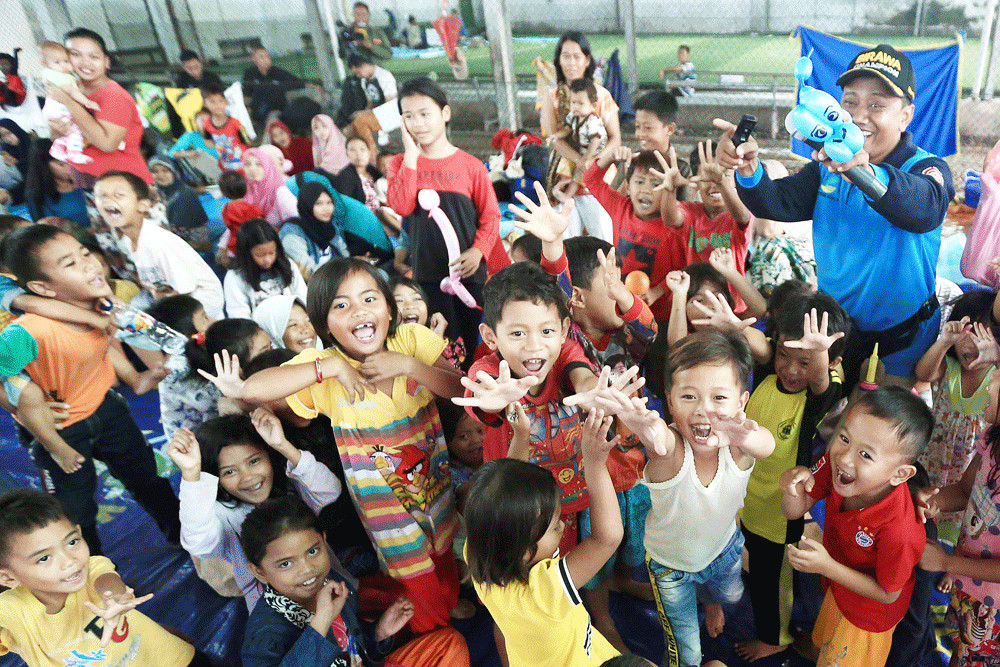Popular Reads
Top Results
Can't find what you're looking for?
View all search resultsPopular Reads
Top Results
Can't find what you're looking for?
View all search resultsSpread of pneumonia poses fatal threat to our children
The general lack of knowledge about the risk factors for pneumonia and the best ways to prevent and cure the disease has caused widespread deaths from pneumonia in children, primarily because of inadequate care.
Change text size
Gift Premium Articles
to Anyone
D
espite wide acknowledgement of the significant progress Indonesia’s vaccination program has made in keeping children safe from infectious diseases, the Health Ministry recently released data that indicate an increase in the prevalence of pneumonia in 2019. It seems that many children are missing out on the pneumococcal vaccine, which is the most effective way to protect them from the disease.
Unlike other childhood diseases, such as diarrheal diseases, measles, mumps and rubella, pneumonia receives relatively little attention. The general lack of knowledge about the risk factors for pneumonia and the best ways to prevent and cure the disease has caused widespread deaths from pneumonia in children, primarily because of inadequate care.
Pneumonia is an acute lower respiratory tract infection that is one of the leading causes of death and illness in children under 5. Pneumonia has been blamed for most child deaths caused by respiratory illnesses. The 2018 Basic Health Survey (Riskesdas) shows that the prevalence of pneumonia increased last year to 2 percent from 1.85 percent in 2013. Nationwide, confirmed cases of pneumonia in children under 5 have increased by about 500,000 per year from 2015 to 2018. Confirmed cases of pediatric pneumonia last year reached 505,331, of which 425 patients died.
According to the Health Ministry, July saw 121,645 confirmed pneumonia cases among children under 5, with 699 deaths. But under-5 children exposed to the risk of pneumonia were estimated to number more than 993,000, or 3.55 percent of the total under-5 population in Indonesia. In Jakarta, the figure was 44,339, or 4.24 percent of the capital’s under-5 population.
Pneumonia is the second-most common infectious disease affecting under-5-year-olds in Jakarta after diarrheal diseases.
Sadly, exposure to secondhand smoke has been found to be among the risk factors for childhood pneumonia, alongside non-exclusive breastfeeding, malnutrition, low birth weight and the absence of and/or incomplete immunization. Many parents who smoke are unaware of the impact their habit can have on their children’s health.
“The probability of children catching pneumonia is much higher if they live in a family with many pneumonia risk factors, including indoor pollution such as secondhand smoke exposure,” the ministry’s disease control and prevention director general, Anung Sugihantono, told The Jakarta Post in an interview on July 17.
Extensive exposure to the toxic chemicals in tobacco smoke may cause passive smokers to suffer frequent coughs and colds. Experts say that cigarette smoke sticking to clothes, walls and furniture can also cause illness, including pneumonia in children under 5.
Last month’s death of National Disaster Mitigation Agency (BNPB) spokesman Sutopo Purwo Nugroho to lung cancer was the latest to reveal the dangers of secondhand smoke exposure. In a video testimony circulated widely on social media following his death on July 7 in Guangzhou, China, Sutopo says most workers at his office smoked and that he suffered chronic coughs and bone pain before doctors diagnosed him with stage IV lung cancer.
Sutopo wonders aloud in the video that perhaps he developed the disease because he was a passive smoker. “I was not a smoker [when I was diagnosed with lung cancer]. No one in my family smoked. I followed a healthy lifestyle,” he says. Later, he calls on all people to stay away from cigarette smoking: “To the younger generation, especially children, please don’t smoke. No one will think that you look cool if you smoke as portrayed in [cigarette] advertisements. That is misleading. Stop smoking. Remember, it’s not just for you, but [also] for your family’s health.”
The Health Ministry has responded swiftly to prevent deaths from pneumonia, stepping up efforts in early diagnosis and management of pneumonia and treatment through the integrated management of childhood illness (MTBS) preventive program at community health centers (Puskesmas) and clinical networks, including auxiliary public health centers, village birth centers and village health centers. The government hopes to prevent deaths from pneumonia in babies and children under 5 through the MTBS program.
Introduced in 1996 by the World Health Organization in Indonesia, the MTBS program offers thorough medical checkups at primary care facilities for children showing symptoms of pneumonia, which are similar to the flu, like coughs, a fever and chills, as well as difficulty breathing. The program aims to identify pneumonia in children as early as possible for immediate treatment.
Pneumonia is also the most common cause of death from measles in children.
Vaccination against childhood diseases like pertussis, measles, Haemophilus influenza and pneumoccal infections remains the primary preventive step in the fight against pneumonia.
Since environmental factors also influence the spread of pneumonia, the disease can be prevented through effective, cost-efficient ways. These include exclusive breastfeeding, healthy dietary habits, hand hygiene and last but not least, creating a home environment that is free of indoor pollution, including secondhand cigarette smoke. They are small but essential steps that, unfortunately, have been given relatively little attention, leaving many children at higher risk of getting this fatal but preventable disease.











